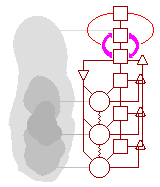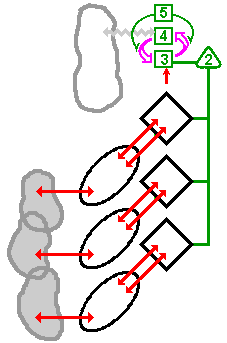Introduction Preface Section 0: Cybernetic Eyes Section 1: The Quick Guide to the VSM Section 2: Case Studies Hebden Water Milling 1985 Triangle Wholefoods 1986 One Mondragon Co-operative 1991 Section 3: Preliminary Diagnosis Janus interlude Section 4: Designing Autonomy Section 5: The Internal Balance Section 6: Information Systems Section 7: Balance with the Environment Section 8: Policy Systems Section 9: The Whole System Section 10: Application to Federations Bibliography Links Appendix 1: Levels of Recursion Appendix 2: Variety  This work is licensed under a Creative Commons Attribution-NonCommercial-ShareAlike 4.0 International License. |
Section 9: THE WHOLE SYSTEMIn this Section, all the aspects of the Viable System are brought together and looked at as a whole system. All the individual aspects have been covered in the previous sections on Internal Balance, External Balance, Information Systems, Autonomy and Policy. The current task is to see how they can all work together as a single, integrated, harmonious organisation. Whole System Responses.This description is to give you some idea about the way that all of the various systems interact. I am taking a hypothetical situation at a hypothetically designed Suma in which all my ideas of Viable System design have been implemented. (!) That is ...
The situation: Due to immanent changes in legislation, wholefood shops will no longer be capable of bagging down their own goods. The situation has been monitored for some months by System 4, who has been liaising with the Packing Department and with the Personnel Officer. System 4 has done some market research and predicted that when the new laws come into effect the entire balance of sales is likely to change from bulk goods to pre-packs. On consultation with System 3, it turns out that there is plenty of spare capacity in terms of machinery but that the number of trained operatives is dangerously low. Immediately, System 3 organises a training program to ensure that there will be enough trained members should the demand for pre-packs go through the roof. System 4 has also predicted that the new situation may require a further 11 staff. The question is: how sure can we be that the predicted demand for pre-packs will happen? Each department is told to review its personnel and decide if it can cope in the short term if some of its members have to be diverted to the pre-packing department. Meanwhile 4 new members are recruited (as a safety net) and trained just before the new laws come into effect. When the laws change, demand for pre-packs does escalate, staff is diverted according to an optimisation plan worked out in advance by System 3, and casual labour is called in by each department to fill the gaps. Personnel System 3 begins to recruit and train more full time members, and the indicators monitor the Operation looking for signs of stress. An Algedonic is generated from the order-pickers showing that productivity and accuracy have dropped dramatically. Examination shows that the best pickers have been moved to pre-packing and more training and some further relocation is needed. Meanwhile System 4 is thinking about diversifying into Fish. System 3 says absolutely no way until there are enough people to cope with the pre-pack surge. And besides, the Hub reports that the membership have serious doubts about the policy constraints ... Whole System DesignThe story on the previous page contains a large set of assumptions all of which are necessary for the system to function in the way described: Systems 3 and 4 must have been properly designed so that they have the capabilities to
In reality, if the demand for pre-packs did suddenly escalate, Suma would be taken by surprise and would move into crisis mode. Lots of untrained casuals would be called in, productivity would fall accordingly, and the implications would ripple through the organisation. Not enough trained people in the warehouse, not enough order pickers, book-keeping affected as admin staff are relocated ... And so on. Perhaps the most dramatic difference is that current accountability systems work on a three month period and so major problems (for example a dramatic drop in productivity) would not be noticed for weeks or even months. [June 1992 - interestingly enough, in the last few months the possibility of a surge in pre-packs was recognised and a pre-pack co-ordinator was given a budget of 25 days to research the external environments and make proposals (classic system 4 activity) The results were to invest in different machinery which would be capable of responding to any sudden surge in pre-pack sales.] The design of all these elements has already been covered in the preceding Sections of the Pack. It may be summarised in three parts:
How it all Works ... As all five systems are continuously interacting, it is impossible to begin at the beginning, because wherever you start, there will have been something else already going on. But nevertheless, let us begin with the day to day interactions between the Operation and its environment. In a period of relative calm, each Operational unit will get its orders, do its job, and work according to the criteria set by the whole organisation. System 2 and 3 will be monitoring all of this and may be looking at some sort of optimisation plan, but generally will not be having much impact on the Operation. This is like the body at rest. The heart and liver are doing their jobs, in the context of the base brain, but the higher brain functions may be watching television. Then the situation changes, and System 4 identifies a possible opportunity, (such as the new market need for pre-packs), and begins to assess possibilities. This is the situation in which the whole system must function in an integrated fashion. Consider the way your body functions in this situation: Suppose that the phone rings (while you are asleep) and a friend says "We are going to London, in 15 minutes. If you can get to the station, there's a spare ticket for you!" Immediately, System 4 goes into overdrive. "15 minutes to get to the station ... no money for a taxi ... got to find my coat and scarf ... its about a 10 minute run ... should be alright." The System 4 plan is sent to System 3. "Need to run to the station" The plan is sent to System 1 - the Operational units - muscles are activated, the heart and lungs increase their activity drastically. All of this is monitored by Systems 2 and 3 who supervise the interaction of muscles and organs and the flow of adrenaline. System 3* monitors all of this looking for signs of strain.. It may well be that the System 4 plan - to run to the station - is outside the capabilities of System 1, and the information systems from System 1 send an algedonic to the brain saying "ouch ... terrible pains in my legs" whereupon the brain will assess the situation and may alter its plan accordingly. Assuming you are fit enough to carry out the plan, your internal environment will be kept stable and you will get to the station. Plan complete! All of this will be within the context of your personal policy systems (for example a plan to steal a car was excluded), and the essence is the continuous interaction of the External and Internal eyes, formulating and modifying plans in the context of policy. Diagrammatic Representation. Consider the following VSM diagram
The essence of the whole system is the balance between the internal (1, 2 & 3) and the external (3, 4, & 5). Systems 1, 2 and 3 are the Inside and Now, and keep the internal environment stable and optimised and generally working well according to the dictates of their environments. Systems 3, 4 and 5 are looking at future plans in the light of both the external environment, and of the capabilities of the Operation. Whole system balance requires that these two aspects, which will often be in conflict, are balanced. For example, the Sales Director may be willing to place strains on the Operation in order to achieve a profitable sale. From the point of view of the internal environment, the task is to optimise the use of resources. This may not be in line with what the Sales director wants. In co-operatives there may be a disagreement between the members who think in System 4 mode (let's go for this opportunity ...) and those who are more concerned with leaving things as they are and maximising the use of internal resources. Whatever the details, it is crucial to balance the requirements of the external environment with the internal capabilities of the Operation. This is essence of Whole System Design. |
||||||||||||

